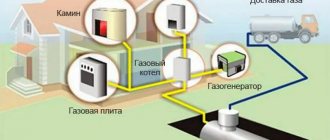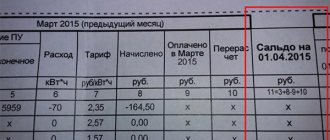You can heat a private house with solid or liquid fuel boilers, as well as with electric and gas heating equipment. Operating boilers of the first type is a rather troublesome and expensive task, because you constantly need to bring in fuel, load it into the working chamber of the boiler, and clean the chimney and boiler from ash.
Electric boilers and water heaters are easy to maintain, but consume a lot of electricity, so the home owner will have to pay considerable utility bills every month.
The most economical option is to use gas heating, because blue fuel is an inexpensive energy resource and after connecting the house to the gas main, the owner will only need to follow safety rules and carry out timely maintenance of gas appliances. This article will tell readers how to supply gas to a private home and what documents are required to collect to obtain a gasification permit.
Which houses can be connected to gas supply?
Centralized gas supply provides for the transportation and delivery of natural gas to the consumer. Connecting a permanent structure to the gas main includes two stages - organizational and technical actions. The set of organizational measures includes the preparation and collection of the necessary technical documentation, filing an application for gasification and concluding an agreement in the event of a positive decision by the gas service.
Technical actions: connecting the gas main to the land plot, connecting the house to the gas distribution network, installing a gas meter and starting the gas.
Gasification of a residential building is clearly regulated by law. According to Government Decree No. 1314, gas connections are permitted to capital buildings. If residential, country or garden houses, as well as garages and utility buildings, have a strong connection to the ground, that is, they are installed on a foundation and registered as real estate, then there will be no problems with their connection. In any other case, gasification will be denied. An attempt to connect gas supply to non-capital construction projects is prohibited by law and, depending on the consequences, is punishable by a fine or criminal punishment. In an apartment building, gas is connected to the entire house. To connect permanent buildings located on the territory of garage cooperatives, gardening or holiday villages, an application for technological connection is submitted by the owner of the territory.
What is required by law
It is most profitable to connect to the central gas pipeline. This is cheaper and safer than installing an autonomous gas supply using a gas tank or gas generator. According to the law, only capital construction projects can be connected to the network - those that have a foundation. You can also supply gas to an unfinished house. Gas cannot be piped into garages, sheds, greenhouses, summer buildings and other structures without a foundation. An application for connection can only be submitted by the owner or tenant who has permission for this matter from the owner.
All “gas” nuances in Russia are regulated by the federal law on gas supply.
Required Documentation
To consider an application for technological connection of a residential building to the gas distribution network at the gas distribution organization (GRO), you need to collect the following documentation:
- documents confirming the applicant’s ownership of the house and land;
- a document confirming the compliance of the technical conditions of the house with the gas distribution network (TU);
- copy of passport;
- diagram of the land plot and adjacent territory;
- calculation of planned gas consumption;
- gasification project.
The application also indicates the location of the house that needs to be connected to the gas main, the applicant’s passport details and postal address, email address or telephone number for contact. The application can be submitted in electronic format on the GRO website, sent by mail or at the document acceptance center of the gas distribution organization. For the unreliability of documents attached by the applicant in electronic format, the legislation provides for administrative liability. The address of the GRO can be found in local authorities or found on the Internet, indicating the name of the subject of the Russian Federation.
Stages of gasification at home
The Contractor reviews the application within three days from the date of receipt. If the applicant has not fulfilled all the requirements, he is notified that he must provide all missing information and documents within 20 days. Consideration of the application is suspended at this time.
Ownership documents
If you are not the sole owner of the land plot, then consent to gasification of all adult owners is required. Your rights and the rights of other owners can be represented by third parties under a power of attorney executed in a notary's office.
If your house is connected to the gas distribution network from a neighboring plot, the consent of the owner of the plot is required. However, power assignment is possible only if the neighboring building has been connected to the same gas distribution network for at least 5 years and there are no technical contraindications to connecting a new consumer.
A land plot diagram (situation plan) can be obtained free of charge from the local administration, as well as from the BTI and from cadastral engineers, however, you will have to pay for their services. The calculation of the planned gas consumption is compiled by the contractor’s employees (GRO). If it does not exceed 5 cubic meters. m. per hour, no document is required.
Where to go and what to pack
The first thing you need to do is find out where the gas pipeline closest to your home is and who runs it. As a rule, this will be a local gas company. This is where you will need to go for permits and papers.
In general, supplying gas to a house, depending on the region, will cost from 75,000 to 750,000 rubles.
First of all, you need to get technical specifications from gas workers. This is a kind of permission to connect to the gas pipeline, plus a guarantee that blue fuel will flow into your home without interruption and in the required volume.
In order for these technical conditions to be drawn up for you, you will have to bring a whole bunch of papers to the city gas department. Here is the list:
- passport (+copy);
- certificate of ownership of the house and land (+ copies);
- land plan;
- calculation of maximum fuel consumption per hour (needed if your house is more than 200 square meters and you want to install a gas boiler with a power of more than 30 kW);
- request for the issuance of technical conditions (here you need to indicate when you want to start gas and the estimated gas consumption).
The most complete list of documents for registration of technical specifications can be found here.
The gas distribution company must prepare the technical conditions 14 days in advance. The technical conditions will be valid for 70 days.
Life hack: how to calculate the maximum gas consumption yourself
You can calculate the maximum hourly gas consumption that you will need for technical conditions yourself. It all depends on the power of the gas appliances that you install in the house, and on the area of the house itself. So, for 100 square meters of living space, gas consumption will be about 1.3 cubic meters per hour. A four-burner gas stove consumes approximately 1 cubic meter per hour, an oven another 0.25 cubic meters per hour. We add these indicators and get the desired figure. If you don’t know exactly what kind of gas appliances you will have, you can indicate the consumption of 5 cubic meters, since houses up to 200 square meters or even more usually fit into this figure. Then there is no need to separately calculate the maximum gas consumption; it is enough to indicate this consumption in the request. You can also calculate it using an online calculator. If it is difficult for you to do the calculation yourself, you can order it from the same gas companies for an additional fee. Prices and tariffs in all regions for such services are different.
Technical conditions for gasification of a residential building
A request for technical specifications is also submitted to the gas distribution service. They cannot refuse to accept an application for the provision of technical specifications if gasification is permitted by law and the applicant has submitted all the required documents. The examination will be carried out within the established time frame.
The basis for refusal to issue a document on technical specifications may be the lack of possibility of technological connection. In this case, the contractor must notify the customer about the approximate timing of such an opportunity. If the contractor unreasonably refuses to issue the technical specifications document, the customer may file a claim in court to force the issuance of the necessary documents and compensation for damage caused by such refusal.
The technical specifications document indicates the following parameters:
- maximum gas flow (m3/hour);
- name of the property;
- timing of connecting the house to the gas distribution main;
- characteristics of the network at the connection point;
- validity period of the technical specifications.
The calculation takes into account the area of the house, as well as the technical characteristics of heating and water heating equipment. When developing specifications, the throughput of the gas main and the number of connection points are taken into account. The connection point is the place where the gas consumption network is connected to the gas main.
Connection point of the house to the central gas system
According to the established regulations, the house must be connected at one point. If there are two residential buildings on the site, it is possible to connect each house separately.
The technical specifications document is valid for 70 days, excluding weekends, unless the date of its validity is indicated. During this time, you need to have time to develop a gasification project and conclude a connection agreement. If you do not meet this time, you will have to re-conduct a technical examination and draw up a report.
New rules
In June 2021, the State Duma adopted a law according to which the population has the opportunity to supply gas to the borders of their property for free. Until this time, main gas was carried only to the borders of the populated area.
Law No. 184-FZ of June 1, 2021, amending Law No. 69-FZ “On Gasification in the Russian Federation” (located in the legal system Guarantor and Consultant) established standards for social gasification, that is, free connection of private houses to existing or new ones gas distribution networks.
At whose expense will gas be supplied to the site?
If in the locality where a private house is located there is already a gas pipeline or is being laid, then all work on laying the gas pipeline will be paid for by the state. In this case, citizens will pay the cost of gas equipment, as well as work on laying communications on the site and inside the house.
Which areas will be subject to the law: free gasification of a private home in 2021 in rural areas
Households located in settlements where, as of January 1, 2020, intra-city and intra-village gas distribution networks were installed (Government Order No. 1152-r dated April 30, 2022) can participate in the social gasification program. In addition, the land plot must meet the following requirements:
- in the locality where it is located, a gas distribution pipeline was installed and commissioned before 01/01/2020;
- the site is located at a distance of no more than 200 meters from the existing gas pipeline;
- the volume of consumption on the site (residential building, bathhouse, garage, etc.) does not exceed 7 m3 per hour (this volume allows heating an area of 300 m2).
Which houses can be connected to gas supply?
Private houses for gas supply must meet the following requirements:
- gas boilers are placed in the basement or ground floor, no more than 2 in one room;
- in the room where the boilers are located, double-glazed windows can be installed, but provided that the design allows them to be knocked out quickly;
- a residential building must be equipped with devices that monitor pressure and temperature in the gas system and a gas consumption meter;
- the gas stove is installed at a distance of 1 meter from the opposite wall;
- gas equipment intended for installation has a certificate and all necessary attachments;
- If a gas stove is installed under a canopy, it must be equipped with blow-out protection.
Kitchen requirements:
- ceiling height of at least 2.2 meters;
- the presence of a gap under the door and a window for ventilation, with opening doors;
- volume of at least 8 m2 for a 2-burner stove, 12 m2 for a 3-burner stove and 15 m2 for a 4-burner stove.
What to do to get gas for free
To participate in the social gasification program, you need to collect a package of documents and submit an application to the GRO; you can use the official portal of the Unified Gasification Operator of the Russian Federation (address httpss://connectgas.ru) or by visiting the office of the regional GRO.
The package of documents should include:
- request for the issuance of technical specifications;
- copies of documents confirming ownership of the land and house;
- a copy of an identity document;
- land plan;
- owner's consent and power of attorney if documents are submitted by a third party.
Russian President V.V. Putin ordered to increase the gasification level to 82.9% by 2030. In order to fulfill the instructions and implement the social gasification program, regional authorities establish subsidies based on the Housing Code of the Russian Federation and the Law “On State Social Assistance”, based on the costs incurred under this program for the following categories of citizens:
- participants, disabled people and widows of WWII participants;
- home front workers;
- Leningrad siege survivors and minor prisoners of concentration camps;
- disabled people of groups 1 and 2;
- large families with 3 or more children.
Who will carry out free gasification
The implementation of the social gasification program will be carried out by a single gasification operator, Gazprom, including its subsidiaries. These services will be provided to the population on the basis of comprehensive agreements concluded with the operator.
Can they refuse connection?
If a plot of land or a house located on it does not meet the requirements of the gasification program, the gas distribution department will refuse to connect.
If a refusal is received due to incorrect or incomplete documentation, the applicant receives a notification and has the opportunity to correct the shortcomings within 20 days and resubmit the documents.
Gasification project
Project documentation is drawn up based on information about the specifications. The list of documents includes the following information:
- the place where the gas pipe enters a private house;
- distribution of communications throughout the facility and inside the house;
- list of necessary work when connecting;
- security measures;
- work estimates;
- recommendations on the technical characteristics of gas equipment.
Gasification project for a private house
To develop design documents, the designer takes the necessary measurements on site, taking into account the customer’s wishes regarding the location of gas appliances. The gasification project can be drawn up by specialists from the gas distribution company, but the law provides for the possibility of engaging third-party companies to develop the project, but their services will be more expensive. However, in this case the documentation will be compiled faster. When contacting a third-party design organization, you need to check that it has a license to carry out this work.
Previously, a project for gas distribution throughout the house was needed only for buildings of 3 floors or higher with 1 family living. However, according to SP 402.1325800.2018, from 06/06/2019, the gas supply project will become mandatory in other cases when connecting to gas.
Results
Free gasification of private houses in accordance with Federal Law No. 184 dated June 1, 2021 must be completed by 2030. Considering that applications for connection are already being accepted throughout Russia, you need to send your documents to the gas distribution department as quickly as possible, otherwise the deadline for gasification of your particular site may be pushed back very far, given the large number of applicants.
You may also be interested in: How to force the administration to make a road in a village.
Fee for gas connection to a private house
After completing all legal formalities, the contractor sends an application to the executive body for tariff regulation to establish the cost of technological connection. In this case, the customer must be notified no later than 5 days from the date of sending the application. The application is accompanied by a connection agreement, a positive expert opinion of the estimate and design documents, estimate documentation indicating the cost of each type of work.
Having studied all the documentation, the executive authority, within 22 days, excluding weekends, approves the amount of payment for each type of work separately. If the applicant refuses to connect the household to the gas pipeline after concluding an agreement and conducting examinations, the owner of the household will compensate the contractor for all confirmed expenses.
Installation of a gas pipeline to a private house
The connection fee obliges the contractor to bring the gas distribution network to the connection point and prepare the facility for gas start-up no later than the deadlines established by the contract. Distribution of communications around the site and inside the applicant’s house is paid separately. If this work is carried out by specialists from a gas distribution organization, then their cost will be calculated according to tariff rates. To save time for carrying out work within the boundaries of the site and inside a permanent structure, third-party companies can be hired. In this case, payment is calculated at market prices.
Installation of a meter when introducing gas into the house from outside
If a gas distribution network is laid to the border of the site, installation work to supply gas to a private house for citizens of the first category must begin no later than 9 months after payment for the technological connection. Connecting the house to the gas pipeline must be completed within 10 days from the start of work.
The final stage of installation work is installing the meter, connecting gas appliances, checking the system for possible leaks, checking ventilation and testing the gas. This work can only be carried out by GRO employees. After this, a certificate of readiness is signed, the owner of the house receives a technical inspection receipt, and the documents are again sent to the gas distribution organization. Within three weeks, city gas workers must come and seal the gas meter. Then a gas supply agreement is concluded with the consumer and the capital structure is included in the gas supply system. These relations are regulated by Government Decree No. 549.
Insertion into the central gas pipeline to connect a residential building
How a gas pipeline is built (connecting a gas line to a house)
With an approved project, you must contact a company that deals with similar work (necessarily with a state license). If the estimate drawn up by the company suits both parties, then an agreement is concluded to carry out the relevant work.
The contract must indicate that the final payment will be made only after all work has been completed and accepted by the official commission.
Upon completion of installation work, as-built production and technical documentation is drawn up, which must be approved by the commission. After successfully connecting the gas line to the house, you can immediately conclude an agreement for the installation of the equipment that will be connected (boiler, stove, etc.).
Commissioning work should be carried out exclusively by gas specialists Source gasworld.ru
Benefits and subsidies for gas supply to a private home
According to Federal Law No. 69-FZ (as amended on July 26, 2019), Article 24 approves a list of persons who can be provided with benefits and subsidies for connecting gas supplies to private households and supplying gas. These include the following categories of citizens:
- pensioners;
- disabled people of groups I, II, III;
- veterans, combatants and their widows;
- large families;
- liquidators of the Chernobyl accident;
- low-income families.
The amount of benefits is regulated at the federal and regional levels. In most cases, a 50% discount on gas connections is provided to owners of private houses belonging to these categories of citizens. However, regional authorities of individual constituent entities of the Russian Federation can return up to 90% of the connection cost. Veterans and disabled people of the Second World War, survivors of the siege, as well as persons over 80 years of age, can be provided with 100% compensation.
Payments for gas connection to the house to benefit groups
To apply for compensation, you need to contact the social insurance fund at your place of registration. You need to have with you:
- Passport.
- Documents confirming ownership of a capital structure.
- Pension certificate (for pensioners).
- Medical documents confirming disability (for disabled people of groups I, II, III).
- Certificate of family composition.
- Certificate of income (for low-income citizens).
- Agreement with a gas distribution organization and a gas supply agreement.
- Acts of completed work.
- Payment receipts (to confirm the purchase of gas equipment and gas supply connection).
If false information is provided, there is a debt, missing documents or an incorrectly completed application, compensation will be denied. Working pensioners may also be denied a subsidy. According to the law, preferential categories of citizens are required to confirm their status annually.
In conclusion of the article, it is worth noting that the ease of use and low cost of blue fuel will pay for the troublesome and expensive gasification procedure.









